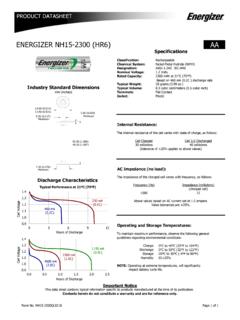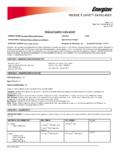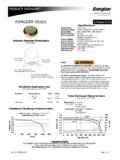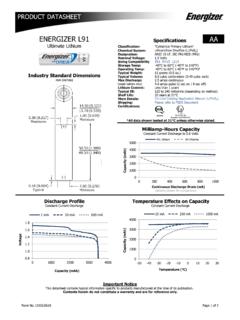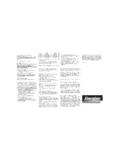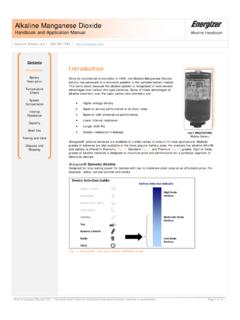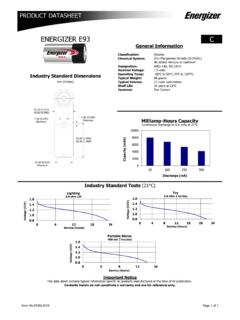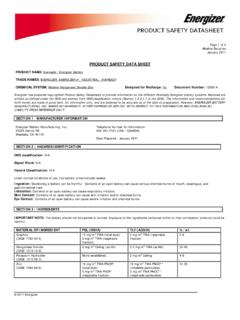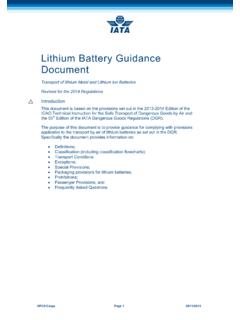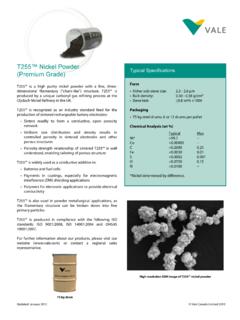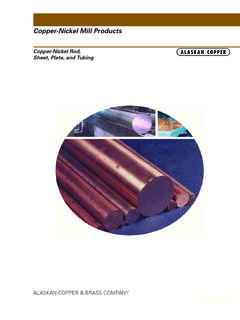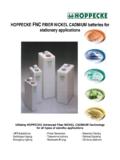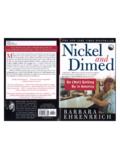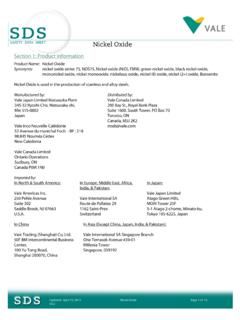Transcription of Nickel Metal Hydride (NiMH) - Energizer
1 Nickel Metal Hydride (NiMH) Handbook and Application Manual Nickel Metal Hydride Energizer Brands, LLC. | 800-383-7323 | 2018 Energizer Brands, LLC. This document was prepared for informational purposes only. Do not use this document as a legal citation to authority. Page 1 of 14 Contents herein do not constitute a warranty of service, features or performance Introduction The number of portable battery operated electronic devices has grown tremendously. Consumers can be confused as to which battery to buy for these devices. This handbook will provide a better understanding of rechargeable Nickel Metal Hydride (NiMH) batteries, their use, and advantages for the consumer.
2 Many battery applications are well suited to be powered by NiMH rechargeable batteries. In general, devices that require large amounts of energy and are used frequently are well matched to the performance characteristics of NiMH batteries. Examples of these devices would include digital cameras, GPS units, and MP3 players. Early AA NiCd rechargeable batteries provided approximately 25% of the capacity of alkaline non-rechargeable batteries. However, the latest AA NiMH batteries provide approximately 75% of the capacity of alkaline AA batteries at low drain rates and can surpass alkaline performance in high drain applications ( digital cameras). The true advantage of NiMH batteries can be found in the cycle life (reuse after charging).
3 Typically NiMH batteries can be recharged hundreds of times, potentially allowing them to be equivalent to hundreds of alkaline batteries in total service over their lifetime. However, battery life is limited to 5 years or less. This can make rechargeable NiMH batteries a cost effective power source for many frequently used battery operated devices found in the home or office. Some of the advantages of the Nickel - Metal Hydride battery are: Energy density which can be translated into either long run times or reduction in the space necessary for the battery. Elimination of the constraints on battery manufacture, usage, and disposal imposed because of concerns over cadmium toxicity.
4 Simplified incorporation into products currently using Nickel cadmium batteries because of the many design similarities between the two chemistries. Greater service advantage over other primary battery types at low temperature extremes operating at -20 C. Typical Applications The Nickel - Metal Hydride battery is currently finding widespread application in those high-end portable electronic products where battery performance parameters, notably run time, are a major consideration in the purchase decision. History of NiMH Batteries Nickel - Metal Hydride batteries are essentially an extension of the proven sealed Nickel -cadmium battery technology with the substitution of a hydrogen-absorbing negative electrode for the cadmium-based electrode.
5 While this substitution increases the battery s electrical capacity (measured in ampere-hours) for a given weight and volume and eliminates the cadmium which raises toxicity concerns, the remainder of the Nickel - Metal Hydride battery is quite similar to the Nickel -cadmium product. Many application parameters are little changed between the two battery types. (Table 1) compares key design features between battery chemistries. Contents Introduction Battery Description Discharging Characteristics Charging Characteristics Storage Device Design Considerations Care and Handling Disposal and Recycling Nickel Metal Hydride (NiMH) Handbook and Application Manual Nickel Metal Hydride Energizer Brands, LLC.
6 | 800-383-7323 | 2018 Energizer Brands, LLC. This document was prepared for informational purposes only. Do not use this document as a legal citation to authority. Page 2 of 14 Contents herein do not constitute a warranty of service, features or performance Typical Application Features NiMH vs. Lithium Primary NiMH vs. Alkaline Rated Voltage vs. vs. Discharge Capacity NiMH will not last as long as primary lithium (single cycle) NiMH lasts longer in high drain, less in light drain devices than alkaline Recharge Capability Several hundred cycles for NiMH, N/A for lithium primary Several hundred cycles for NiMH, N/A for alkaline primary Discharge Voltage Profile Both relatively flat discharge NiMH is flat vs.
7 Sloped for alkaline Self Discharge Rate NiMH retains 50-80% @ 12 months Lithium retains >90% @ 15 years NiMH retains 50-80% @ 12 months Alkaline retains 80% @ 10 years Low Temperature Performance Lithium better than NiMH NiMH better than alkaline Battery Weight Lithium is lighter Alkaline is lighter Environmental Issues Recycling options available for NiMH and lithium Recycling options available for NiMH and some alkaline Table 1 - Summary Comparison of AA-AAA Nickel - Metal Hydride , Primary Lithium and Alkaline General Characteristics Typically can be recharged hundreds of times. Efficient at high rate discharges. Significantly higher capacity than Nickel -cadmium batteries.
8 Typical expectancy life is 2 to 5 years. Operates well at a wide range of temperatures: Charging 0 C to 50 C Discharging 0 C to 50 C Battery Description The Nickel - Metal Hydride battery chemistry is a hybrid of the proven positive electrode chemistry of the sealed Nickel -cadmium battery with the energy storage features of Metal alloys developed for advanced hydrogen energy storage concepts. This heritage in a positive-limited battery design results in batteries providing enhanced capacities while retaining the well-characterized electrical and physical design features of the sealed Nickel -cadmium battery design. A cutaway (Fig. 1) of a typical cylindrical NiMH battery is illustrated in the following diagram: Contents Introduction Battery Description Discharging Characteristics Charging Characteristics Storage Device Design Considerations Care and Handling Disposal and Recycling Nickel Metal Hydride (NiMH) Handbook and Application Manual Nickel Metal Hydride Energizer Brands, LLC.
9 | 800-383-7323 | 2018 Energizer Brands, LLC. This document was prepared for informational purposes only. Do not use this document as a legal citation to authority. Page 3 of 14 Contents herein do not constitute a warranty of service, features or performance Click here for larger view (Fig. 1) Typical NiMH B attery Electrochemistry: The electrochemistry of the Nickel - Metal Hydride battery is generally represented by the following charge and discharge reactions: Charge At the negative electrode, in the presence of the alloy and with an electrical potential applied, the water in the electrolyte is decomposed into hydrogen atoms, which are absorbed into the alloy, and hydroxyl ions as indicated below.
10 Alloy + H2O + e` Alloy (H) + OH` At the positive electrode, the charge reaction is based on the oxidation of Nickel hydroxide just as it is in the Nickel -cadmium couple. Ni(OH)2 + OH` NiOOH + H2O + e` Discharge At the negative electrode, the hydrogen is desorbed and combines with a hydroxyl ion to form water while also contributing an electron to the circuit. Alloy (H) + OH` Alloy + H2O + e` At the positive electrode, Nickel oxyhydroxide is reduced to its lower valence state, Nickel hydroxide. NiOOH + H2O + e` Ni(OH)2 + OH` Negative Electrode The basic concept of the Nickel - Metal Hydride battery negative electrode emanated from research on the storage of hydrogen for use as an alternative energy source in the 1970s.
